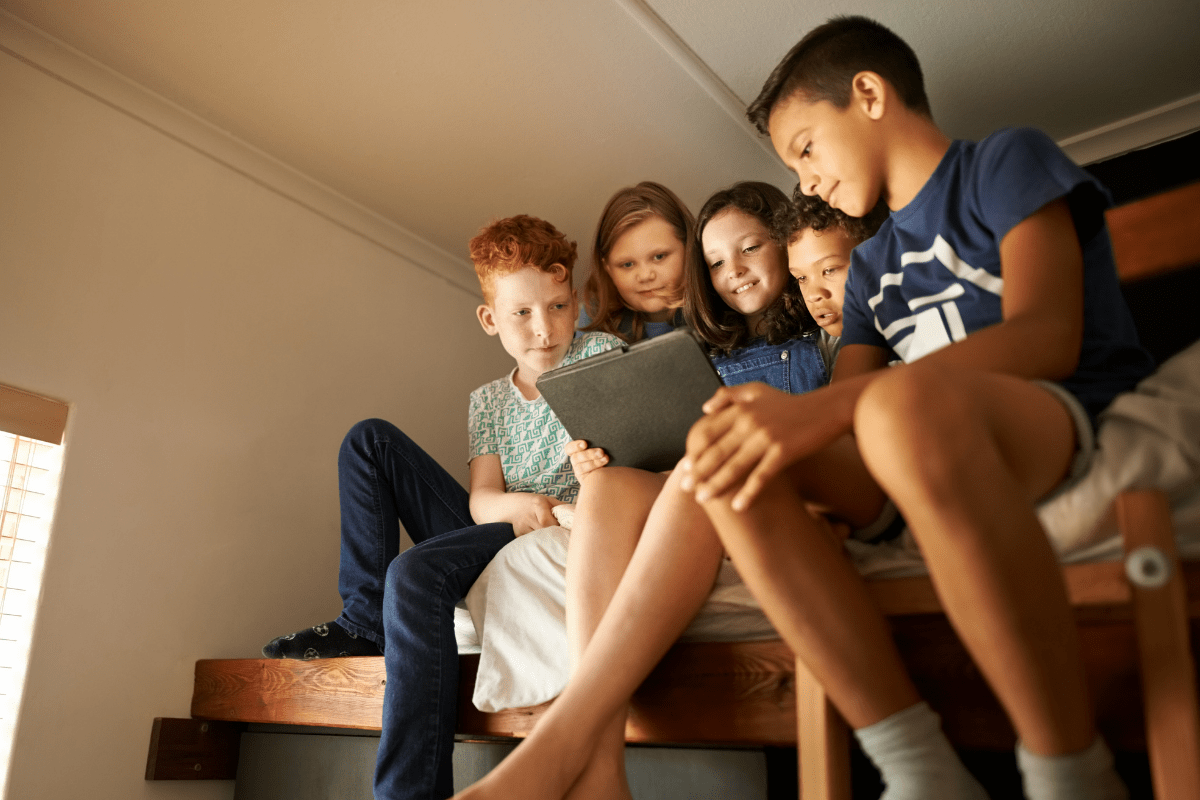Let's be honest: technology isn't going anywhere, and neither are the daily negotiations about screen time that happen in virtually every household with kids. You know the drill… "Just five more minutes!" followed by epic meltdowns when those five minutes inevitably turn into twenty. The good news is that creating healthy tech habits doesn't require becoming the family screen police or throwing all devices out the window (though some days that sounds tempting).
Start with the stuff that actually works
Before diving into complex rules and philosophical debates about screen time, let's focus on the tools and strategies that busy families can actually implement without losing their minds.
The magic of device parking stations
Here's something that sounds simple but works like magic: create a physical spot where devices go when people come home. This could be a basket by the front door, a charging station in the kitchen, or even just a designated drawer. The key is making it automatic, like taking off your shoes when you walk inside.
When everyone (yes, parents too) puts their phones in the same spot, it creates a natural transition from "outside world mode" to "family time mode." Kids stop automatically reaching for devices, and parents stop reflexively checking notifications during dinner conversations. It's not perfect, but it's a start that doesn't require constant reminding or enforcement.
Apps that help instead of hinder
Technology problems often need technology solutions, which feels a bit ironic but works surprisingly well. Apple's Screen Time and Android's Digital Wellbeing come built into most phones and tablets, giving parents basic controls without downloading anything extra.
For families who want more comprehensive management, apps like Qustodio or Circle Home Plus offer dashboard-style control across multiple devices. These platforms let you set different rules for different kids, which is crucial when you have a teenager and a preschooler who definitely shouldn't have the same digital boundaries.
The real game-changers are apps that encourage quality over quantity. PBS Kids, Khan Academy Kids, and Epic Books provide educational content that actually engages kids instead of just keeping them quiet. When screen time includes learning, those daily negotiations become less about "too much" and more about "what kind."
Timing strategies that prevent meltdowns
Nothing triggers a family argument faster than abruptly yanking a device away from a kid who's deep into their favorite game. The solution is building transition time into your routine instead of hoping kids will magically develop impulse control.
The transition warning system works like this: "You have 10 more minutes" followed by "5 more minutes" then "time to wrap up." This gives kids' brains time to process the upcoming change instead of going straight from engaged to enraged. It's not foolproof, but it definitely reduces the drama.
For eye health, optometrists recommend the 20-20-20 rule: every 20 minutes of screen time, look at something 20 feet away for 20 seconds. This sounds ridiculously specific, but it actually helps prevent the eye strain and headaches that come from staring at screens too long. Apps like Forest or Eye Care 20 20 20 can send gentle reminders if you're not great at remembering.
Age-appropriate guidelines that make sense
The challenge with screen time advice is that most of it treats all kids the same, which anyone with children knows is completely unrealistic.
The early years: building good habits from the start
For babies under 18 months, the American Academy of Pediatrics recommends avoiding screens entirely except for video chatting with grandparents or other family members. This might sound extreme, but it's based on how babies' brains develop and their need for real-world interaction during these crucial months.
Once kids hit 18 to 24 months, high-quality programming becomes an option, but with a major caveat: co-viewing is essential. Toddlers don't automatically understand what they're seeing on screens, so adult participation helps them connect digital content to real-world concepts.
Preschoolers: one hour and done
The magic number for ages 2 to 5 is one hour per day of high-quality programming, preferably with a parent nearby to discuss what's happening. This guideline acknowledges that screens can be educational tools while protecting the brain development that happens through physical play, social interaction, and hands-on exploration.
But here's where real life gets complicated: what counts as "high-quality"? Educational apps that teach letters and numbers definitely qualify. Mindless YouTube videos of people opening toys… probably not. The middle ground includes shows like Daniel Tiger's Neighborhood or Bluey that teach social skills alongside entertainment.
School-age kids: shifting focus from time to content
Once kids turn 6, the official recommendations move away from strict time limits and toward ensuring that technology doesn't crowd out sleep, physical activity, and face-to-face relationships. This makes sense because a 6-year-old using a tablet for homework serves a different purpose than that same kid watching random videos for two hours.
The key benchmarks are: 8 to 12 hours of sleep (depending on age), one hour of physical activity, and meaningful time away from screens each day. If those boxes are checked, families have more flexibility in how they approach screen time.
Why bedtime and blue light matter more than you think
Sleep disruption from screens isn't just about kids being "wound up" after watching exciting content. There's actual biology at play that makes evening screen time particularly problematic for children.
The melatonin connection
Blue light exposure tricks our brains into thinking it's still daytime, which suppresses melatonin production. Melatonin is the hormone that makes us feel sleepy, so when it's suppressed, kids (and adults) have trouble winding down for bed.
Here's the kicker: children are significantly more sensitive to this effect than adults. Research from the University of Colorado Boulder found that preschoolers exposed to light tables before bedtime experienced a 70 to 99% decrease in melatonin levels. That's a massive disruption to their natural sleep preparation.
Teenagers face a double challenge because they're both more sensitive to blue light than adults and naturally programmed to feel alert later in the evening. Adding screens to this mix can push bedtimes even later and make morning wake-ups even more brutal.
Creating a digital sunset
The most effective strategy is establishing a "digital sunset" where all screens turn off one hour before bedtime. This gives everyone's brain time to start producing melatonin naturally instead of fighting against artificial light signals.
During this screen-free hour, families can engage in naturally calming activities: reading together, doing simple stretches, working on puzzles, or just talking about the day. It feels old-fashioned, but it creates space for connection that often gets lost in the rush of daily schedules.
Real-world scenarios and practical solutions
Theory is great, but every parent knows that real life is messier than guidelines suggest. Here's how to handle some common situations without becoming the family screen time villain.
The morning routine challenge
Many families struggle with kids who want to watch cartoons during the hectic getting-ready-for-school routine. The problem is that screens often slow kids down rather than speed them up, leading to missed buses and frazzled mornings.
The "earn your screen time" approach flips this dynamic. Kids who complete their morning checklist (dressed, teeth brushed, backpack packed) with time to spare can enjoy brief screen time before leaving for school. This incentivizes efficiency while providing a small reward for staying on track.
Homework time negotiations
"I need my tablet for homework" has become the new "my dog ate my homework." While devices are genuinely useful for research and assignments, they're also full of distractions that can derail focus.
The Pomodoro Technique works well for families: 25 minutes of focused work with devices in "focus mode" (blocking non-educational apps), followed by 5-minute breaks. Many kids discover that homework actually takes less time when they're not constantly switching between assignments and entertainment.
Long car rides without losing your mind
Road trips and long car rides present unique challenges because kids are confined in a small space with limited entertainment options. The key is creating a balanced plan rather than defaulting to screens for the entire journey.
Try alternating between different activities every 30 to 60 minutes:
- Educational audiobooks or podcasts
- Family games and conversation
- Music and sing-alongs
- Limited educational screen time
- Rest stops for physical movement
This approach acknowledges that some screen time during long car rides is completely reasonable while ensuring kids don't spend four hours passively staring at devices.
Building habits that stick
The most successful families focus on creating sustainable routines rather than perfect adherence to rigid rules.
Model the behavior you want to see
Kids learn more from watching what parents do than listening to what they say. If you want children to put devices away during dinner, your phone needs to stay in another room too. If you want them to choose educational content, occasionally discuss your own media choices and explain your reasoning.
This doesn't mean parents need to be perfect (thank goodness), but it does mean being intentional about modeling the digital habits you hope your kids will develop.
Create together, don't just consume
One of the best ways to improve the screen time equation is encouraging kids to become content creators rather than just consumers. This might involve making stop-motion videos, composing music on apps like GarageBand, writing stories on tablets, or learning basic coding through kid-friendly platforms like Scratch.
Creative activities provide more cognitive benefits than passive entertainment and often lead to pride in accomplishment that watching videos simply can't match. Plus, creation naturally has built-in stopping points, unlike the endless scroll designed into most entertainment apps.
Monthly family tech meetings
Regular family discussions about technology use provide opportunities to assess what's working, what isn't, and how rules might need adjustment as kids grow and circumstances change. Including children in these conversations often leads to more sustainable solutions because they feel heard rather than controlled.
These meetings don't need to be formal or lengthy. Even 15 minutes once a month can help families stay aligned on expectations and adapt to new challenges as they arise.
The long game: building digital wisdom
Perfect screen time balance is a myth, and chasing it will drive you crazy. Some days will involve more screens than you'd prefer, and that's completely normal. The goal is progress toward intentional technology use, not perfection in daily execution.
Gradual independence
As children mature, the focus should shift from external controls to internal decision-making. This means gradually involving kids in creating family guidelines, discussing how different types of screen time make them feel, and allowing them to experience natural consequences of their choices.
A 10-year-old who stays up too late playing games and feels terrible the next day is learning valuable lessons about self-regulation. A 15-year-old who manages their own screen time boundaries while maintaining grades and relationships is developing skills they'll need as an adult.
Celebrating offline achievements
In a world that constantly rewards digital engagement through likes, notifications, and achievements, it's important to make non-digital accomplishments visible and celebrated too. Display artwork, acknowledge reading milestones, and notice when kids choose outdoor play over screen time.
These positive reinforcements help balance the immediate gratification that digital devices provide and remind everyone that some of life's best experiences happen away from screens.
Moving forward without stress
Creating healthy tech habits isn't about achieving some impossible standard of digital minimalism. It's about finding an approach that supports your family's values and creates space for the relationships and activities that matter most to you.
Start with one or two strategies from this guide rather than attempting to overhaul everything at once. Maybe begin with tech-free family dinners or establishing that device parking station. Build consistency with small changes before adding additional boundaries.
Remember that every family is different. What works for your neighbor might be completely wrong for your household, and that's perfectly fine. The most important factor is finding an approach that feels sustainable for your specific situation and allows space for connection, creativity, and rest.
Technology will continue evolving faster than any of us can keep up with, but the fundamental principles of healthy family relationships remain constant: presence, connection, and intentional choices about how we spend our time together. By establishing thoughtful boundaries around technology use, families can harness digital tools' benefits while protecting what matters most.





